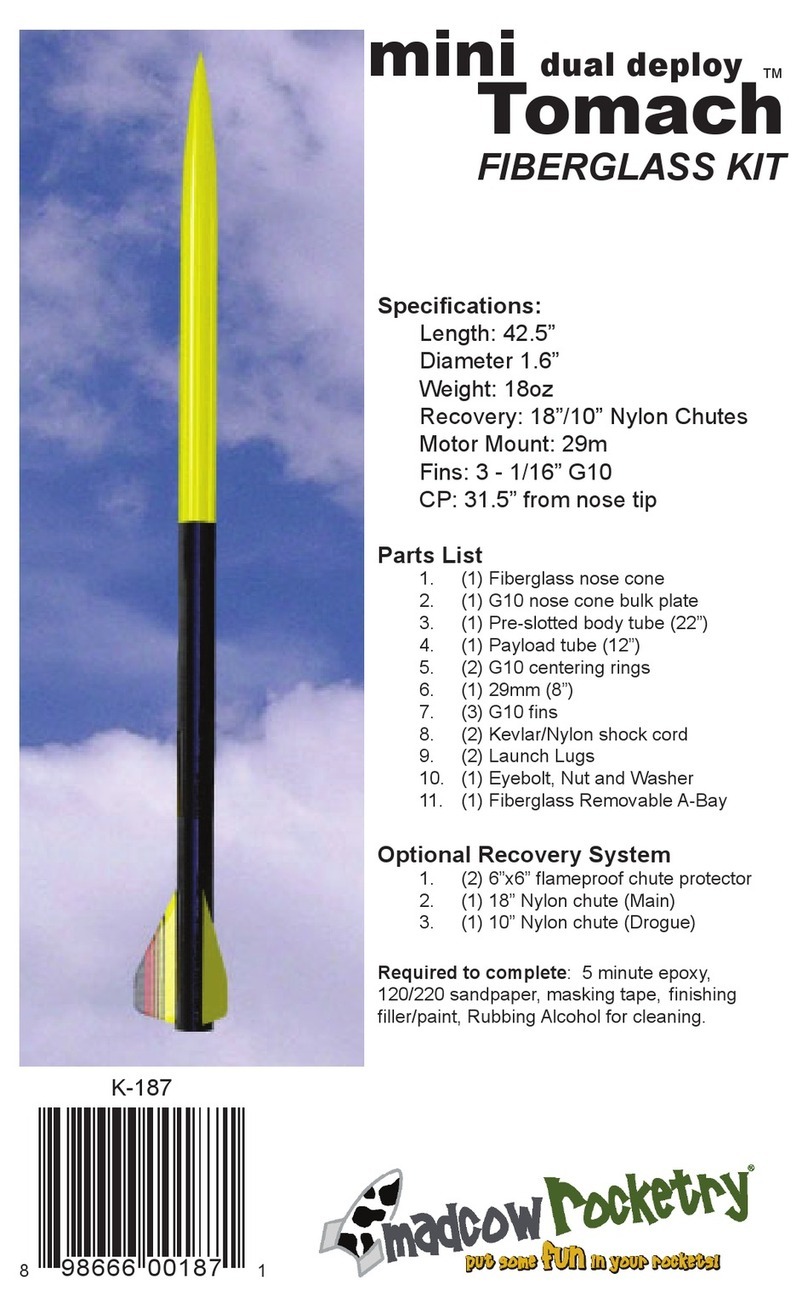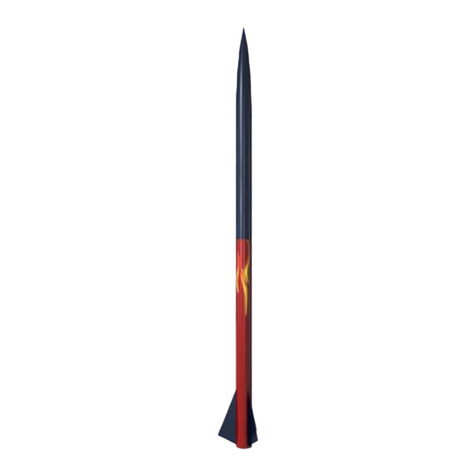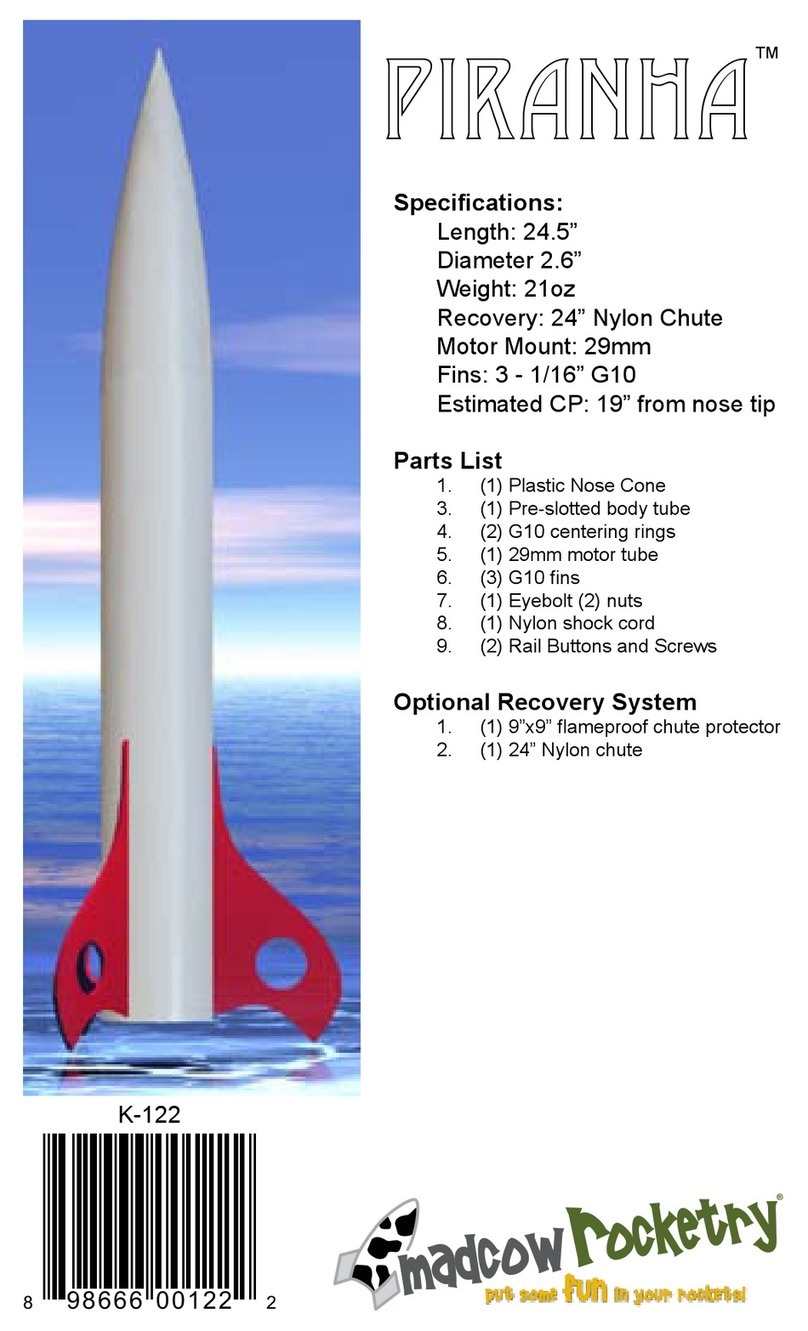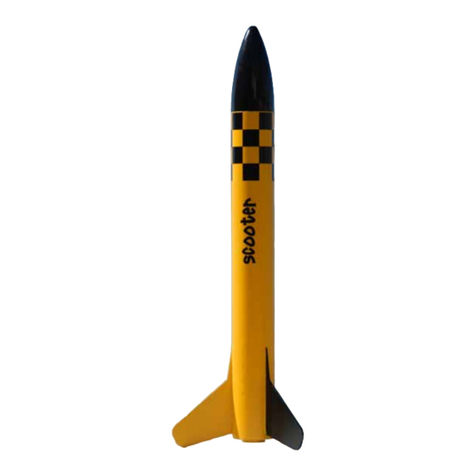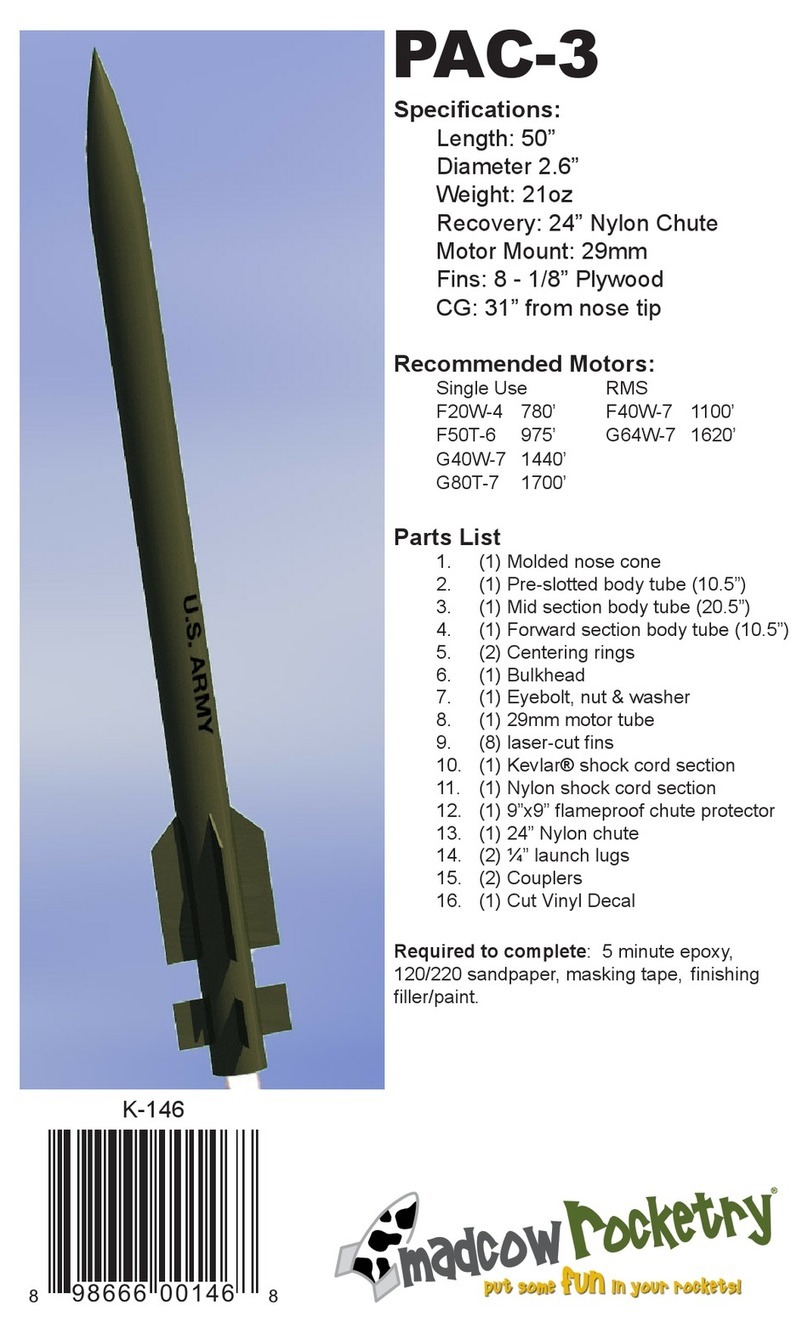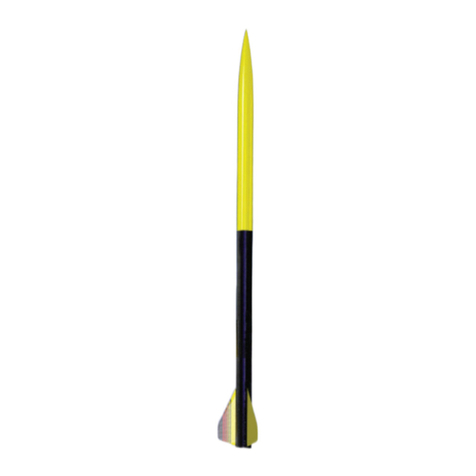
2 ©2014 MadCow Rocketry™ Screech™ Assembly Screech™ Assembly ©2014 MadCow Rocketry™ 3
Please make sure you read all directions and understand how to assemble your model
beforeyoustartconstruction.Itisalsoagoodideatotestteachpartbeforeassembly.
Fiberglass parts still contain small amounts of mold release and other materials on the
surface that will inhibit adhesives and/or paint. It is important to clean each part prior
to assembly with a solution of 1 part rubbing alcohol, 3 parts water and a drop of dish
washing soap. IMPORTANT: do not sand any parts until after you have cleaned them -
youwillembedthematerialsyouaretryingtocleanmakingitdifculttoclean.
The G10 parts will have holding tabs left over from the CNC machine. These small tabs
will need to be sanded off before assembly. Before assembling any part with epoxy,
rough up the surface to be epoxied using course sandpaper. The scratches in the G10
surface will give the epoxy something to grab onto.
Step 1 – Motor Mount Assembly
Step 2 – Insert Motor Tube Assembly into Body Tube
Testteachofthensintotheprecutnslots.BecauseG10thicknessvaries,youwill
need to sand the slot to the correct width. Wrap the shock chord into a small bundle
andstuffitinsidethemotortubeforthisnextstep.Testtthemotortubeassemblyinto
thebodytubetoensureasnugt.Sandthecenteringringsifnecessary.Whenyou
aresatisedwiththet,spreadsomeepoxyontheinsideofthebodytubeandslidethe
forward centering ring of the motor assembly into the body tube. Make sure you have
the motor assembly facing the right way! Spread some more epoxy on the inside
edge of the body tube before sliding the rear centering ring into the body tube. Continue
Ensureringsareclearofthenslots
sliding the assembly inside the body tube
until the aft centering rings are just clear
ofthenslots.It’sagoodideatotestt
anineachslotherebeforetheepoxy
sets. Hold the body tube with the motor
tube assembly down until the epoxy sets.
Make sure the weight of the motor tube
doesn’tcauseittoslideoutofalignment.
Step 3 – Fin Assembly
Using a door jam or small section of angle stock, pencil a line halfway between two of
thensthatextendsfromthefronttothebackofthebodytube.Thislinewillbeused
latertoalignthelaunchlugs.Testteachofthensintotheprecutnslots.Then
shouldseatrmlyagainstthemotortube-sandeachnorslotifnecessary.Whenyou
aresatisedwiththet,applysomeepoxytotheendofthentangthatwillcontactthe
motortube.Also,spreadathinlayerofepoxyoneachsideofthentang.Slidethen
intoplaceandcheckthealignment.Continuerecheckingthenalignmentuntilyouare
suretheepoxyhasset.Cleananyexcessepoxyfromaroundthenjoint.Repeatfor
theremainingaftns.Next,applyepoxylletstobothsidesofeachnbyapplyinga
thinbeadofepoxyatthen-bodytubejoing.Carefullysmooththeepoxylletswithyour
ngerbeforetheepoxysets.Alloweachllettosetbeforerotatingtheairframeforthe
nextllet.
Step 7 – Flying Your Model
Attach the parachute to the shock cord near the nose cone. You can also attach the
chute protector to the shock cord near the parachute. When packing your chute, wrap
the chute protector around the chute with the opening in the chute protector facing
forward. Always make sure your chute is well protected as the hot ejection motor gasses
will melt the nylon chute.
Step 5 – Balancing Your Model
Assembleyourmodelandinsertthelargestmotoryouintendtoy(orsimulatethe
weight with a substitute) and ensure that the CG is at least 1 body diameter in front of
theestimatedCPpointspeciedontherstpage.TheCPpointismeasuredfromthe
tip of the nose cone. If the CG is behind the desired point, add weight inside the nose
cone by pouring lead shot into the nose cone tip and adding some epoxy.
Testtcenteringringsoverthemotormounttubeandsandmotortubeifnecessary.Also
testtthecenteringringsinthebodytubeandsandifnecessary.Spreadsomeepoxyon
the outside of one end of the motor tube and slide the ring (without the notch) until there
is approximately 1/2” of motor tube exposed. Make sure you clean the motor tube of any
epoxysoasnottointerferewiththentangslater.Aftertheaftringisdry,makeamark
1/2” from the other end of the motor tube. Spread some epoxy on the motor tube and
slide the forward ring until it aligns with the mark. VERY IMPORTANT: make sure there
is not any epoxy on the motor tube that would interfere with the n tangs later on.
Fin
Fin Tang
1/2” Exposed
1/2” Exposed
Forward Ring Notch
Push cord in corner and
tack with epoxy
The shock cord in this kit consists
of a shorter section of Kevlar and a
longer section of nylon cording. The
two sections should be tied together
using a single overhand, ring bend
ordoublesherman’sknot.The
Kevlar section will be attached to
the motor mount and the nylon
section will be attached to the nose
cone.
Wrap the end of the Kevlar shock
cord around the forward end of the
motor tube and tack in place with
CA.Makesurethecordlaysat
enough so it will not interfere with
the body tube when you slide the
motor tube inside. Apply some
epoxy to the cord to hold it in place.
Make sure the cord is secure
and will not come loose later with
ejection forces that will pull on the
shock cord.
Step 4 – Launch Lug
Mark the CP point along the launch lug line you made in the previous step. Make sure
you measure the CP point from the tip of the nose cone and NOT the end of the body
tube. Apply a small amount of epoxy on the launch lug line about ¾” long on the CP
mark. Press one of the launch lugs into the epoxy and ensure that it is aligned with the
launch lug line previously drawn on the body tube. You can site down the tube and look
through the launch lug to make sure it is straight. Similarly epoxy the second launch
lugabout2”fromtheaftendofthebodytube(alignedwiththeaftendofthens).Site
down both launch lugs and make sure they are both aligned. If you have a ¼” launch
rod, you can use this to ensure that both lugs are aligned properly.
Tie some knots in the end of the nylon section of the shock cord and lay the shock cord
onto the inside of the nose cone. Cover the shock cord with epoxy to secure it to the
inside, side or tip of the nose cone.
Step 6 – Nose Cone Assembly

